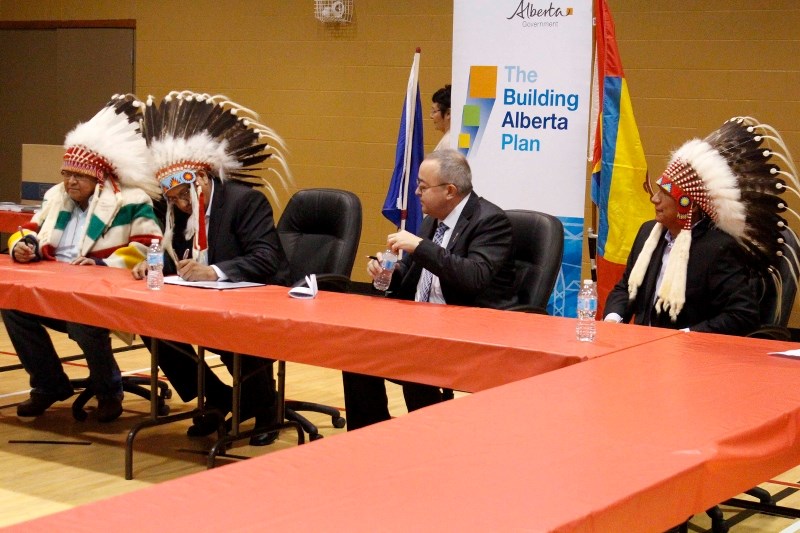The Stoney Nakoda Nation chiefs signed a Memorandum of Understanding (MOU) Dec. 18 with the Alberta government, represented by the Honourable Frank Oberle, minister of aboriginal relations.
The MOU marked a formal commitment between the province and the nation, committing both parties to the rebuild and repair of the 510 nation homes affected by the June 2013 flood.
An estimated $98 million is required for housing recovery in Morley; this figure includes a 10 per cent contingency amount.
“The Alberta government will cover the cost of the rebuild, which is estimated at 98 million,” said Oberle, adding that the government’s commitment goes above and beyond flood recovery and extends to partnerships, assisting families and creating opportunities for increased self-sustainability on the nation.
The ceremony drew some 40-plus nation members, councillors and staff from the respective three bands that make up the Stoney Nakoda Nation (Bearspaw, Chiniki and Wesley) and representatives from the province.
Beginning with traditional Stoney song and drumming and a sweetgrass ceremony, speeches were made by each chief in Stoney and English, as well as a speech made by Oberle and a traditional gift exchange between the minister and the chiefs.
The chiefs spoke of similar themes — how the flood has brought the community together, how important it is for the nation and the government to work together and the need to strive for self-sustainability and the growth of economic opportunities on the nation.
The respective chiefs are Chief Bruce Labelle of the Chiniki band, Chief Darcy Dickson of the Bearspaw band and Chief Ernest Wesley of the Wesley band.
“The devastation (from the flood) brought out the strength of our community…I would like to thank all those involved for their tireless work,” said Bruce Labelle, thanking volunteer and non-profit organizations from communities outside of the nation — including the Red Cross for their efforts.
Darcy Dickson acknowledged that while some nation members might criticize the chiefs for working with the provincial government, Stoneys must think of the long-term focus of the nation: to build self-sustainability and economic independence.
“This reminds us that there is a greater power — where we have no control,” said Dickson. “It brings us together on all levels of government to move forward together…we all know the Nation is put in a difficult position when we face crisis.”
According to the province, the amount required for the nation rebuild, with respect to flood housing recovery is based on professional engineering assessments; the estimated costs include temporary housing during the rebuild, repair of homes, removal and disposal of destroyed homes and the rebuild and associated infrastructure costs such as roads, gas, water and sewer systems.
Around 500 temporary housing spaces are being sought for the Stoney Nation, including 200 for Wesley, 200 for Chiniki and 100 for Bearspaw members; this is mainly in the form of mobile home units.
The province estimates that most costs for First Nations’ housing recovery (including Stoney Nakoda and Siksika First Nations) will be submitted and recovered through the 2013 Alberta disaster recovery programs.
The damages on the Siksika First Nation were more severe, whereas the damages were more widespread on the Stoney Nakoda Nation, although not as severe. By comparison, the damages on the Siksika First Nation are estimated at $92 million (including a 10 per cent contingency); some 153 homes on the Siksika Nation were damaged and 347 flood evacuees are living in the five relief shelters on that nation.




